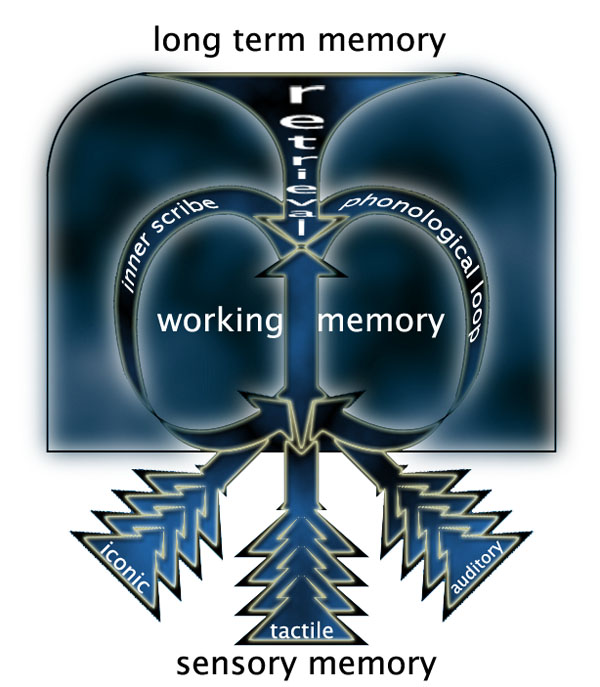Inventions of Memory
Although hugely influential, the model has a few unfortunate shortcomings.
Most importantly, memory is not a static process. Memory decays unless it follows the cycle of learning, encoding, recall, and recoding. In contrast, the classic "modal" model distinguishes storage functions from processing functions - i.e., one is a "black box" and one is a "black arrow." Unfortunately, this distinction is artificial, because the brain contains only arrows: processing (activation) and memory (synaptic efficacy) are two sides of the same coin, and memory itself is a process.
Second, all arrows are not created equal. "Architectural" differences (such as the synaptic efficacy of recurrent connections) among different parts of the brain lead to different processing profiles. These profiles can differ in terms of bandwidth, or in other words, how much information they are capable of holding at a time. Orthogonal to bandwidth, these profiles can also differ in terms of decay rate (or alternately, vulnerability to interference): that is, some regions are capable of maintaining information indefinitely while others are capable of maintaining memories for less than one second.
Third, multiple processing paths require gating functions. Perhaps the largest advantage of removing the "boxes" from the traditional "box and arrow" diagram is that one must become explicit about the functions performed at every step. As a result, such diagrams will be more likely to provide a nice one-to-one relationship between cognitive functions and neuroanatomy. And pure-arrow diagrams remove the need for some elusive "executive functioning" box to coordinate and configure the processes; instead, one need only posit a gating function at the intersection of every arrow with another, in which some process allows information to pass along from one arrow to the next (probably based on dopamine fluctuations).
Then Chris describes his own developing model of memory, which is pictured below and to the left. He has drawn his own model to better reflect the physiological realities of memory as he has discovered them to be.
 Sensory Memory. As you can see from the image ...., incoming sensory information has an extremely high initial bandwidth, and a rapid rate of decay, as indicated by the fat, short arrows. Furthermore, there is no rehearsal process, and sensory memory is constantly overwriting itself. This is indicated visually by the multiple arrows which overlap, and quickly diminish in width.
Sensory Memory. As you can see from the image ...., incoming sensory information has an extremely high initial bandwidth, and a rapid rate of decay, as indicated by the fat, short arrows. Furthermore, there is no rehearsal process, and sensory memory is constantly overwriting itself. This is indicated visually by the multiple arrows which overlap, and quickly diminish in width.Working Memory. This process slowly transitions into a relatively low-capacity - and low-decay - polymodal short-term/working memory process, as indicated by the smaller width of the arrows in the middle of the diagram. Importantly, the width of this arrow does not shrink over time, indicating that the rate of decay is extremely low; indeed, we can hold somewhere between 4 and 7 items in working memory (depending on modality) without decay.
This short-term/working memory process feeds two unique rehearsal processes, each of which is relatively robust to decay yet limited in bandwidth: an articulatory rehearsal process, as well as an "inner scribe" which supports imagery functions (such as mental rotation). These rehearsal processes essentially "refresh" short-term/working memory with previous information, allowing it to be maintained over time.
Long Term Memory. Finally, the entire diagram rests above the base of one massive arrow that folds back on itself: this represents long-term memory. Long-term memory has an essentially unlimited capacity, as indicated by this arrow's enormous base width, but is subject to decay and interference over time. Items can be retrieved from long-term memory, at which point a "gating function" permits us to actively think about the past (i.e., rehearse it), or to merely let it recur and disappear again from our "mind's eye."
Read the entire article here.
I am not surprised that Chris has referred to work from Gerald Edelman's lab in previous posts. This model reminds me of some of Edelman's concepts of memory, as described by Rosenfeld in The Invention of Memory. Chris has some very impressive postings on his blog. Be sure to look through them.
0 Comments:
Post a Comment
“During times of universal deceit, telling the truth becomes a revolutionary act” _George Orwell
<< Home